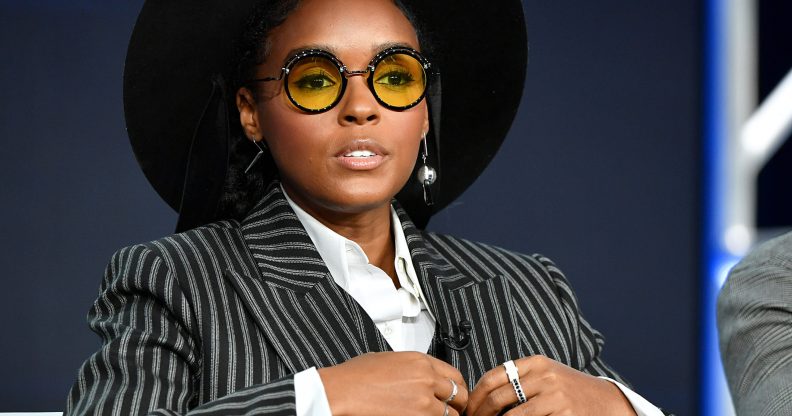No, Janelle Monáe didn’t come out as non-binary. She was just standing in solidarity with the community

Janelle Monáe onstage in Pasadena, California, days after her Steven Universe tweet. (Amy Sussman/Getty)
When Janelle Monae retweeted a Steven Universe GIF and the hashtag #IAmNonBinary last month, the media heralded it as a grand coming-out moment.
‘Janelle Monae just came out as non-binary!!!’ said the internet, in headline after headline, comment piece after comment piece.
Many publications immediately began using they/them pronouns for the star, while some carefully wrote pieces about Monae coming out that omitted using pronouns for the singer altogether.
And at least one publication used the moment to write a guide to using they/them pronouns.
As any non-binary person could tell you, all of these stories share one problematic assumption: that all non-binary people use they/them pronouns.
That this glaringly obvious and entirely inaccurate assumption was perpetuated by the media tells us two things.
There aren’t non-binary people in newsrooms, and there needs to be – all of these pieces, as far as it’s possible to know, were written by cisgender journalists (yes, that is including the ‘guide to using they/them pronouns’ piece).
And journalists, even those working for progressive and trans-inclusive publications, still don’t have a solid understanding of what being non-binary actually means.
Non-binary people use the pronouns that make them feel most comfortable. For some, that’s they/them, and for others, it isn’t.
In the wake of Monae’s coming out, there was one single piece that hit the nail on the head. In it, the writer talked about how Monae’s tweet “reminds us that non-binary does not equal white”.
The writer talked about how white the increasing visibility of the non-binary community is – how Sam Smith, Jonathan Van Ness and even Harry Styles, to some extent, have given non-binary and gender non-conforming people representation in the media. Very white representation.
In a nuanced piece, the writer went on to talk about how “we should not make assumptions” about whether Monae was coming out as non-binary or whether it was “a show of support”, but instead enjoy the queer, Black moment.
“I allowed myself in that moment to just feel good. It felt really good. Oh, and really quite Black,” non-binary performer and activist Travis Alabanza wrote.
The reason that Alabanza could write such an illuminating and smart take on this moment, in a way that no other writer managed, is because they themselves are non-binary.
Their piece stood out. Hugely. It’s unsurprising, just tiring, that no other editor thought to commission a non-binary person to write about Monae’s tweet.
Articles written by cis journalists and edited by cis editors were all over the internet. And they were all wrong.
Janelle Monae was not coming out as non-binary. She was showing solidarity with the non-binary community, and using her platform as a queer, Black artist to shed some light on a marginalised group of people, some of whom are her friends.
In an interview with Roxane Gay in The Cut, almost a month after her ‘IAmNonBinary’ tweet, Monae cleared up what she’d meant by it.
“I tweeted the #IAmNonbinary hashtag in support of Non-binary Day and to bring more awareness to the community,” she said. “I retweeted the Steven Universe meme ‘Are you a boy or a girl? I’m an experience’ because it resonated with me, especially as someone who has pushed boundaries of gender since the beginning of my career.
“I feel my feminine energy, my masculine energy, and energy I can’t even explain.”
The hashtag, which trended worldwide, was an opportunity for the non-binary community to connect, share their stories and learn from each other.
And it could have been an opportunity for cis people to watch and learn, too.

